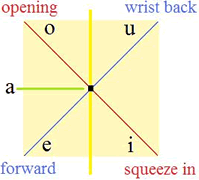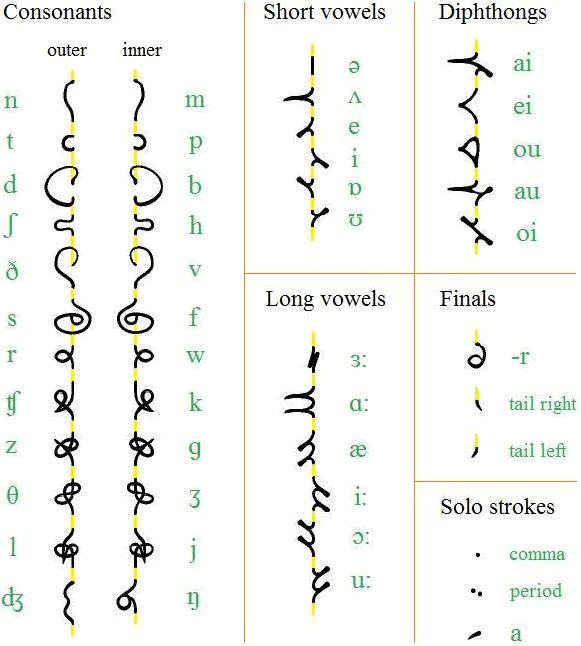Fontok is a kind of shorthand invented by Ian James and inspired by the calligraphic style of China and Japan called wild cursive (k'uang tsao). Mongolian was also an influence. It is in essence a structured scribbling, with phonemes assigned to particular movements of the pen. The name comes from the Thai word for "falling rain", and also has connotations with "font" and "phonetics".
The consonantal phonemes of English were ranked by frequency, and the most common were assigned to the easiest, most natural shapes. Rarer phonemes like /th/ of thing and the /zh/ in measure were assigned to more complicated, less naturally-flowing shapes.
A relatively small set of curves and knots was chosen, and then mirrored to bring the total number up to match the number of consonantal phonemes in English. It turns out that for English, the dental phonemes are generally more common than the bilabials and velars. For this reason, the more natural side of the central axis for forming curves (left side for right-handed writers, right side for left-handed writers) has mainly those phonemes. The mirrored shapes were then given roughly equivalent articulations to those of the main (outer) side.
 The vowels of English can be grouped roughly into 6 pairs of short and long, where
each pair is seen to share similar articulation. A long vowel is simply represented
as duplication of a short vowel.
The vowels of English can be grouped roughly into 6 pairs of short and long, where
each pair is seen to share similar articulation. A long vowel is simply represented
as duplication of a short vowel.
Short vowels are regarded as simple, short lines going out from, and then returning to, a point. A six-way radial system is the basis of assignment. Since there are two main axes of movement at the physical level - wrist rotation (blue) and finger squeezing (red) - the most clearly distinguished vowels are assigned to these. A midway movement is given to the medium frequency vowel /a/, and the most common vowel schwa is a simple line following the vertical axis of the word.
In the following chart of Fontok shapes, the yellow line simply shows the central axis of the writing. For shapes like /s/ and /d/, a slight extension from the end-point, or to the start-point, may be drawn.
When the end of a word is reached, a slight tail may be added for aesthetics; the direction - left or right - is chosen to balance the overall lateral weight of the written word. This is especially useful in the strictly vertical printed font.
The diphthongs are given with simplified phonetics, to show clearly how the shapes are derived from two single vowel marks. The solo mark labeled /a/ is an abbreviated form used for the indefinite article of English

NB. This chart and the vowel diagram were designed for right-handed writers; left-handers can simply use a mirror image of the system.

All human beings are born free and equal in dignity and rights. They are endowed with
reason and conscience and should act towards one another in a spirit of brotherhood.
(Article 1 of the Universal Declaration of Human Rights)
Contact regarding the author's various script systems can be made via email: ianrjames at hotmail dot com.
Akkhara Muni, Amethyst, Bostani, Elektrum, Fontok, Klaekson-Zaen, Maui, New Akha, New Maori, New Mong, Pranish, SIGIL, Sigil Panel Script, Slinseng-Fi, Tengwar for Scottish Gaelic, Xylphika
See also: http://www.skyknowledge.com/orthographies.htm
Constructed scripts for: Ainu | Arabic | Chinese languages | Dutch | English | Hawaiian | Hungarian | Japanese | Korean | Lingala | Malay & Indonesian | Persian | Tagalog / Filipino | Russian | Sanskrit | Spanish | Taino | Turkish | Vietnamese | Welsh | Other natural languages | Colour-based scripts | Tactile scripts | Phonetic/universal scripts | Constructed scripts for constructed languages | Adaptations of existing alphabets | Fictional alphabets | Magical alphabets | A-Z index | How to submit a constructed script
[top]
You can support this site by Buying Me A Coffee, and if you like what you see on this page, you can use the buttons below to share it with people you know.

If you like this site and find it useful, you can support it by making a donation via PayPal or Patreon, or by contributing in other ways. Omniglot is how I make my living.
Note: all links on this site to Amazon.com, Amazon.co.uk
and Amazon.fr
are affiliate links. This means I earn a commission if you click on any of them and buy something. So by clicking on these links you can help to support this site.
[top]